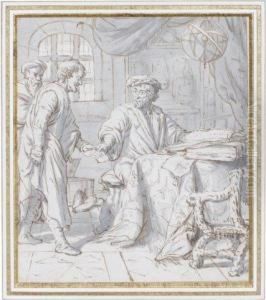Jan Verckolje I Le Vieux Paintings
Jan Verckolje I Le Vieux, born in 1636 in Delft, Netherlands, was a prominent Dutch Golden Age painter, engraver, and draughtsman known for his portraits, genre scenes, and historical subjects. His work reflects the rich cultural and artistic environment of 17th-century Holland, characterized by meticulous attention to detail, a keen observation of light and shadow, and a profound understanding of human emotion. Verckolje's artistic journey began in his hometown of Delft, a renowned center for painting, where he was likely influenced by the works of Johannes Vermeer and other contemporaries.
Verckolje's style evolved over time, showcasing his ability to blend the precise realism of Dutch painting with a softer, more elegant approach. His portraits, often of notable figures of his time, are celebrated for their sophistication, depth, and vitality. He had a unique talent for capturing the essence of his subjects, making his portraits highly sought after by the Dutch elite. Beyond portraiture, Verckolje's genre scenes are notable for their vibrant depiction of everyday life, filled with light, color, and emotion, revealing his keen observation of the social customs and domestic interiors of his era.
In addition to his painting, Verckolje was an accomplished engraver and draughtsman, producing works that were widely circulated and admired. His engravings, characterized by fine detail and delicate handling, contributed significantly to his reputation and the spread of his stylistic influence beyond the borders of the Netherlands.
Jan Verckolje I Le Vieux's contribution to Dutch art was significant, bridging the gap between the early and late phases of the Dutch Golden Age. His legacy is not only preserved in his diverse body of work but also in the influence he had on subsequent generations of artists. He died in 1693, leaving behind a rich oeuvre that continues to be celebrated for its beauty, elegance, and insight into the human condition.
